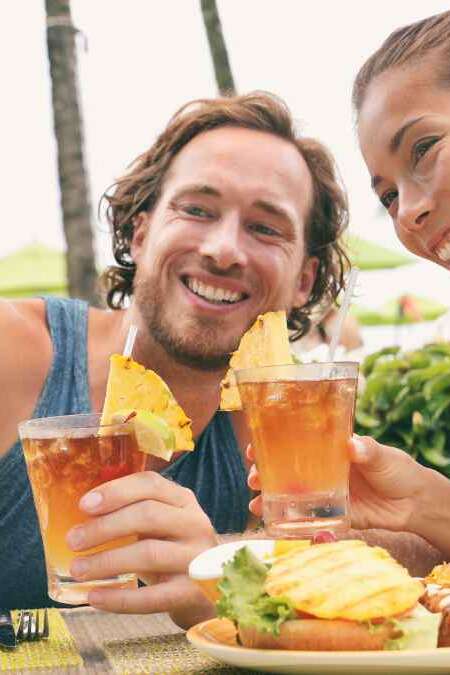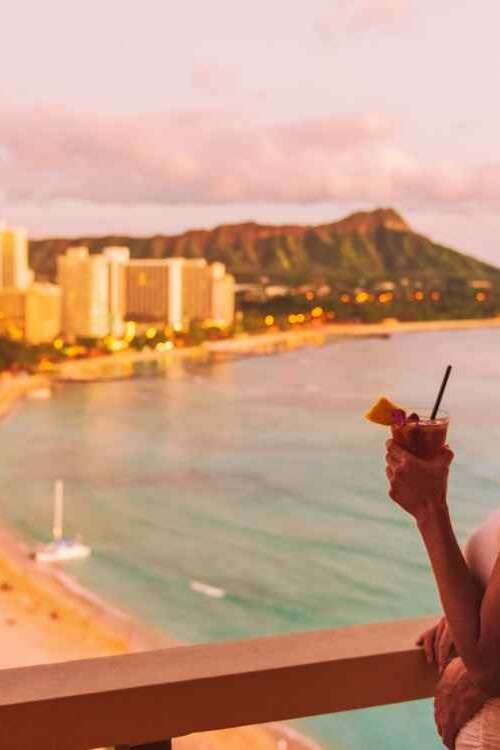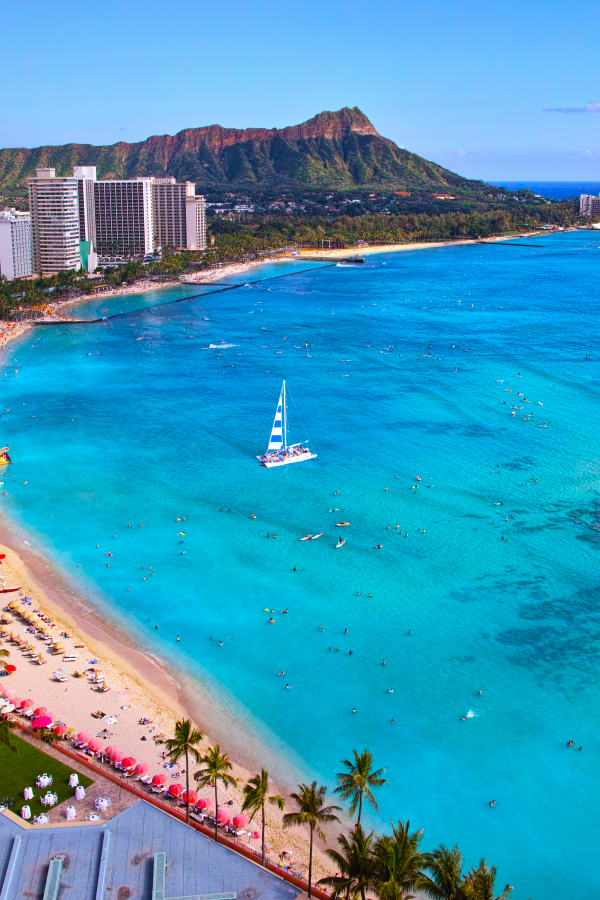Located on the south shore of Honolulu, Waikiki was once a playground for Hawaiian royalty. This world-renowned neighborhood in Honolulu, Hawaii, is a tropical haven that radiates with boundless energy and endless allure. Characterized by its stunning stretch of coastline, it’s truly a melting pot of international diversity. The combination of natural beauty, cultural richness, and recreational opportunities makes Waikiki a must-visit for any traveler seeking a slice of Hawaiian paradise. Let us take you on an unforgettable journey through the wonders of Waikiki.
Highlights
- Waikiki boasts one of the most iconic and picturesque beaches in the world.
- Experience the enchantment of a Waikiki sunset, where the sky transforms into a canvas of vibrant hues.
- Join a sunset cruise or simply relax on the beach as the sun dips below the horizon.
- From traditional hula performances to live ukulele music, the streets are alive with the spirit of aloha.
- For the adventurous souls, a hike up Diamond Head Crater is a must.
- Waikiki is a shopper’s paradise, featuring an array of high-end boutiques, local markets, and international brands.
History
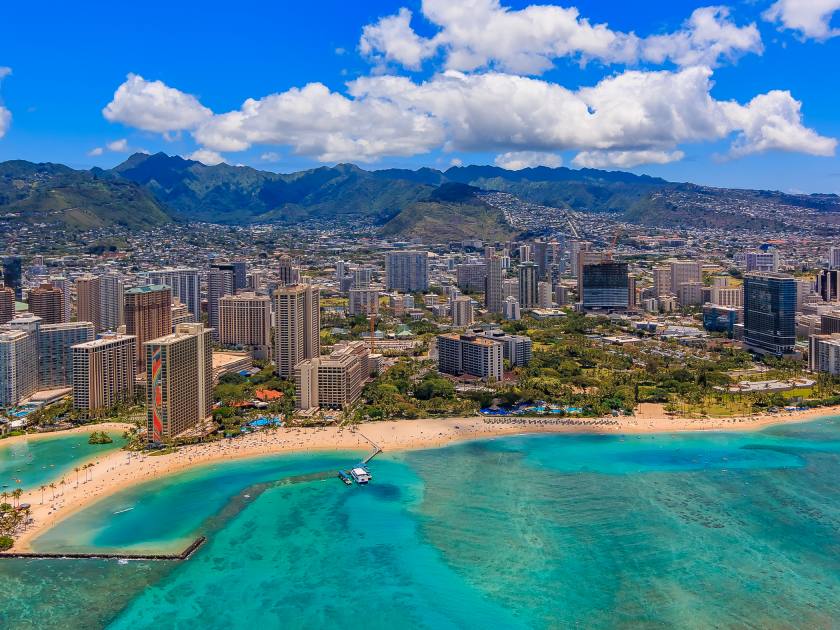
Ancient Hawaiian Roots
Waikiki’s history dates back to ancient times when it served as a favored retreat for Hawaiian royalty. The name “Waikiki” means “spouting waters,” referencing the natural springs that once flowed in the area. The beach was a place of leisure and relaxation for Hawaiian chiefs, with the surrounding land supporting agricultural activities.
The arrival of Captain James Cook in 1778 marked a turning point in Waikiki’s history. Cook’s exploration of the Hawaiian Islands introduced the region to the outside world, leading to increased Western influence. This encounter set in motion changes that would shape the cultural and economic landscape of Waikiki in the years to come.
World War II Impact
During World War II, Waikiki played a significant role as a military rest and recreation center. The war brought an influx of military personnel to the area, and the famous Waikiki Natatorium War Memorial was constructed in honor of the soldiers who served. The war’s end saw a surge in tourism as soldiers returned with fond memories of the Hawaiian Islands.
Development of Tourism
The late 19th and early 20th centuries saw the emergence of Waikiki as a tourist destination. The construction of the Moana Hotel in 1901, followed by the Royal Hawaiian Hotel in 1927, marked the beginning of Waikiki’s transformation into a world-renowned resort area. These iconic hotels played a crucial role in attracting visitors and establishing Waikiki’s reputation as a tropical paradise.
Waikiki is often considered the birthplace of modern surfing. In the early 20th century, legendary figures like Duke Kahanamoku popularized the sport, turning Waikiki into a global surfing mecca. Today, as the Surfing Capital of the World, the Waikiki Beach Boys continue the tradition of sharing the joy of of riding the waves. With their sun-kissed skin and easy smiles, they embody the spirit of Aloha, teaching novices and experts alike the art of dancing with the ocean’s rhythm. These vibrant souls sprinkle a dash of fun and thrill into the Waikiki surf, making every moment an unforgettable adventure!
Geographical Overview of Waikiki
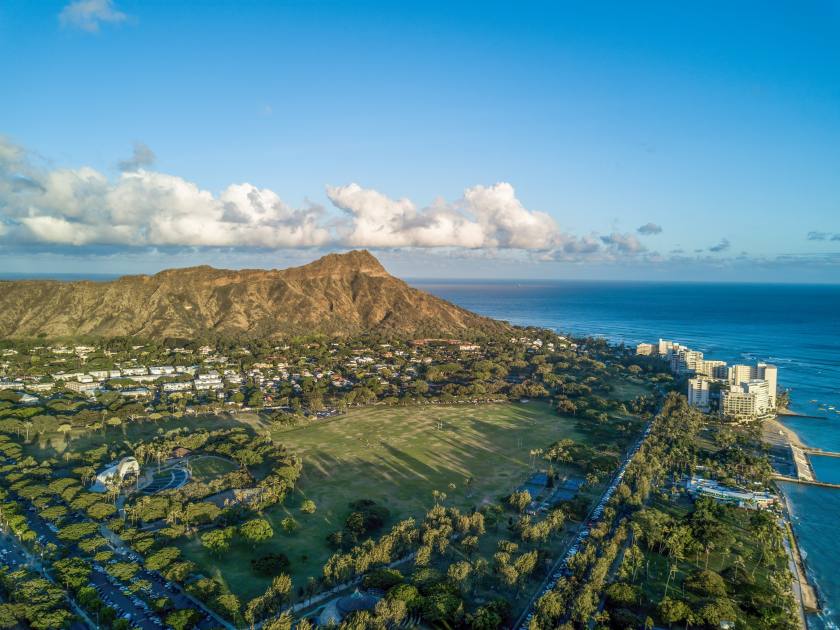
The Waikiki district is blessed with a picturesque landscape that extends approximately 2 miles of the Pacific coastline. The district is framed by the Ala Wai Canal on the north and west, and by the Pacific Ocean on the south. Its eastern boundary is marked by the prominent volcanic tuff cone, Diamond Head, which provides a breathtaking backdrop to the cityscape.
Waikiki experiences a tropical, semi-arid climate, which is characterized by a relatively dry summer season and a wetter winter season. Despite this distinction, the temperature remains fairly consistent throughout the year, with averages ranging from 73°F (23°C) in the cooler months to 81°F (27°C) in the warmer months. The generous sunshine, coupled with moderate rainfall, creates an inviting atmosphere that suits a myriad of outdoor activities throughout the year.
Top Attractions in Waikiki
Waikiki Beach
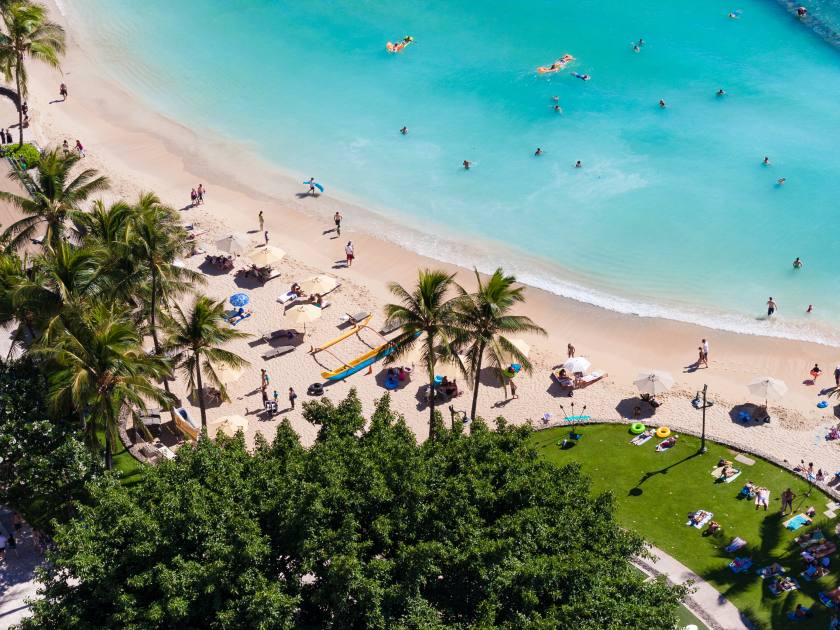
Waikiki Beach, the heart of Hawaii’s beach paradise, captivates visitors with its pristine white sands and crystal-clear waters. This stunning stretch of coastline is more than just a sunbather’s paradise; it’s the birthplace of modern surfing. Pioneered by Duke Kahanamoku, the surfing culture thrives here, making it a bucket list destination for surfers worldwide. From beginners catching their first wave to seasoned pros challenging the surf, everyone becomes part of the surfing legacy in Hawaii. Beyond the surf, Waikiki Beach also offers a plethora of exciting water activities. Whether you prefer a tranquil paddleboard session at sunrise, a thrilling jet-ski ride, or exploring the vibrant marine life through snorkeling, Waikiki Beach promises an unforgettable seaside adventure.
Diamond Head Crater Hike
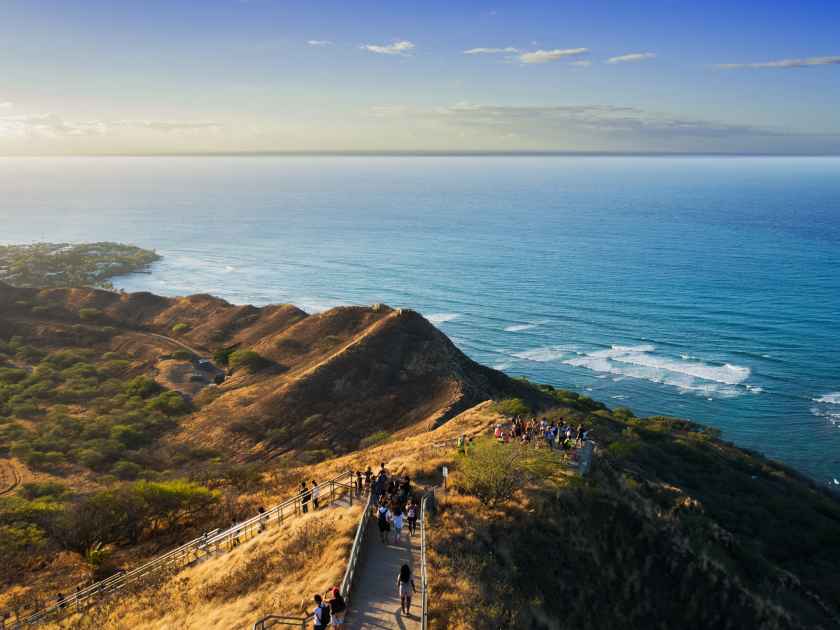
Embarking on the Diamond Head hike is an adventure not to be missed in Waikiki. This famous volcanic crater is a jewel of the Hawaiian landscape that promises an exhilarating Oahu hiking experience. The trail, once a part of the island’s coastal defense system, carries historical significance that adds to the uniqueness of the journey. As you ascend the trail, you are greeted by challenging terrain that rewards you with panoramic views of the Pacific Ocean and the entire cityscape of Waikiki. The breathtaking vista from the summit, the vast blue ocean stretching infinitely into the horizon, and the lush greenery that surrounds you truly exemplify the enchanting beauty of Waikiki.
Cultural Experiences
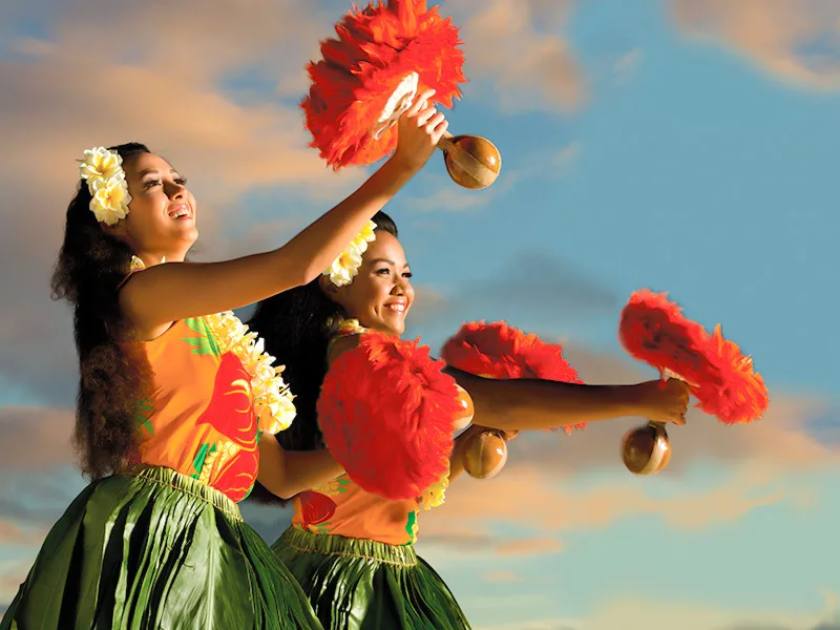
Beyond the impeccable beaches and thrilling hikes, Waikiki enchants visitors with its vibrant cultural experiences. Traditional luaus offer a sensory feast, where attendees can savor succulent Kalua pig cooked in an imu (ground oven), witness the captivating rhythm of the hula dance, and immerse in the rich lore of Hawaiian mythology. Hula performances, a vital part of Hawaiian culture, are frequent across Waikiki, serving as a melodious window into the island’s history and traditions. Additionally, local markets in Honolulu present a kaleidoscope of fresh produce, artisanal crafts, and culinary delights, reflecting the multi-ethnic tapestry of Hawaii. These Hawaiian cultural experiences provide a profound connection to the island’s heritage, offering more than just a getaway, but a journey into the heart of Hawaiian culture.
Shopping and Dining
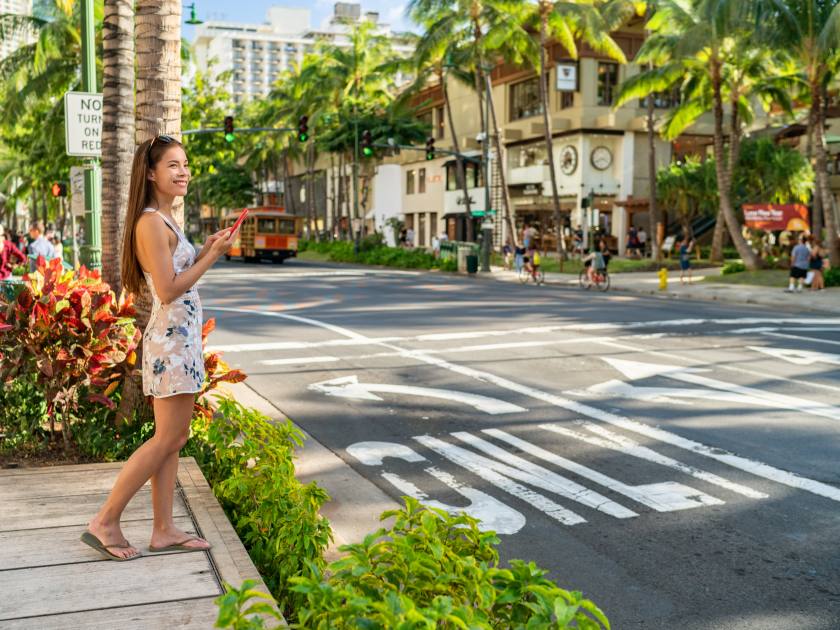
Waikiki invites visitors to indulge in a shopping and dining experience as vibrant as its scenic beauty. Known as the “Rodeo Drive of the Pacific,” Kalakaua Avenue boasts a range of upscale boutiques, local shops, and designer outlets, making “Waikiki shopping” a delight for fashion enthusiasts and souvenir hunters alike.
But the allure of Waikiki extends beyond its shopping scene. The city promises a gastronomic journey that mirrors its cultural diversity. Whether you’re a foodie seeking “fine dining in Honolulu” or someone looking to discover authentic “Hawaiian cuisine,” Waikiki’s restaurants offer a variety of culinary delights. From oceanfront dining at award-winning restaurants to local food trucks serving up traditional Hawaiian fare, your palate is in for a treat.
Sunset at Waikiki Beach
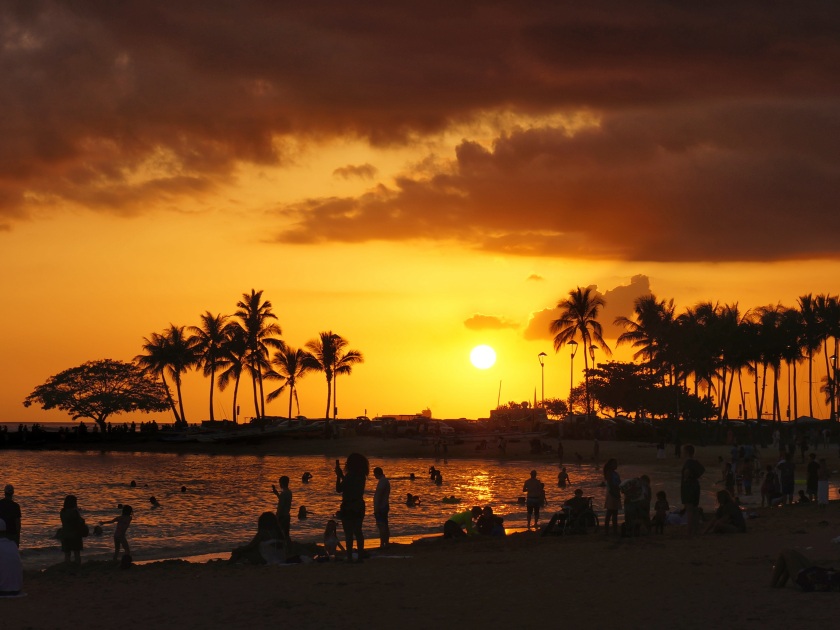
As the sun begins to descend, Waikiki Beach transforms into a magical spectacle of colors. The sky erupts into a canvas painted with hues of fiery oranges, pinks, and purples, reflecting on the tranquil ocean waves. The “Waikiki sunset” is truly an unforgettable vision, a mesmerizing phenomenon that adds to the already captivating beauty of this Hawaiian haven. During this time, the beach becomes a hub for “romantic beach strolls,” with couples walking hand-in-hand, leaving footprints on the soft sand, as the last rays of the sun add a golden glow to their serene surroundings. For a unique perspective of the sunset, “sunset cruises in Hawaii” offer an unparalleled experience. On board, one can witness the sun dipping below the horizon, concluding the day, and welcoming the starlit night, all while the Honolulu cityscape fades into the distance.
Outdoor Activities in Waikiki
Surfing
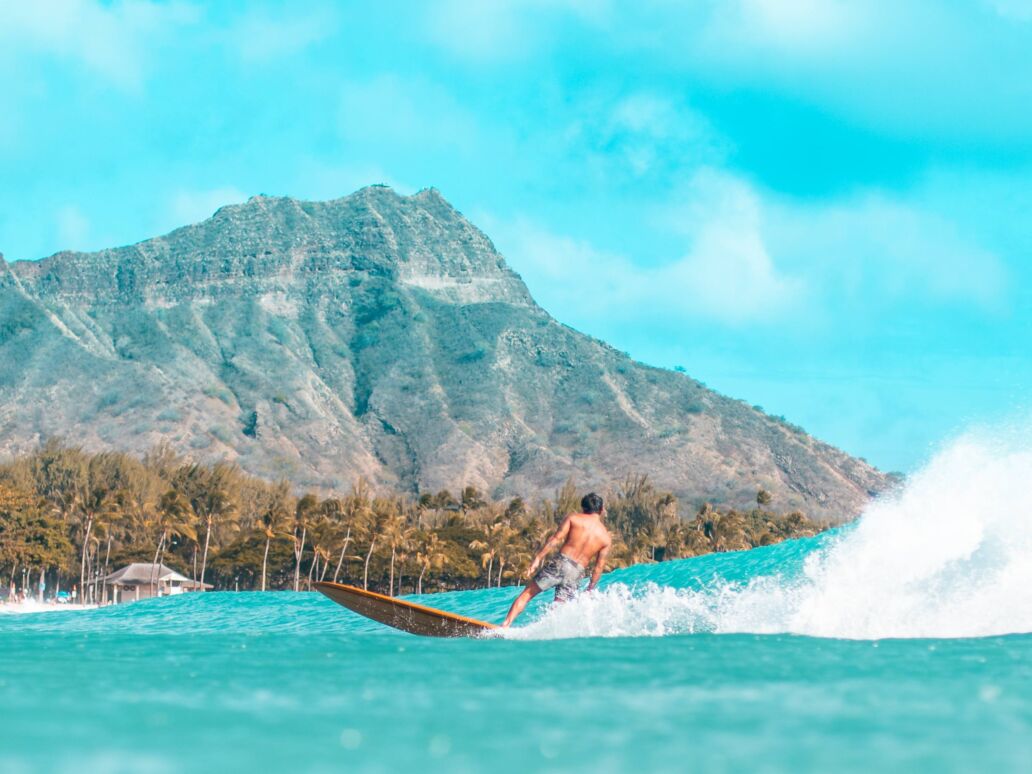
Catch a wave at one of the world’s most iconic surfing destinations. Waikiki offers ideal conditions for beginners and veterans alike, with several surf schools lining the beach to guide newcomers. The welcoming turquoise waves of Waikiki Beach set the perfect stage for a memorable surfing experience.
Snorkeling
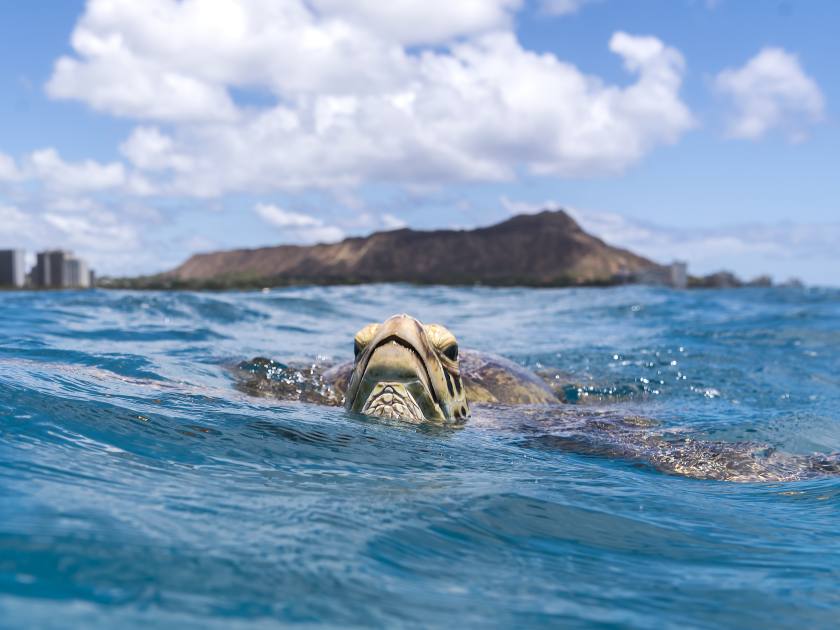
Waikiki’s crystal-clear waters are home to a colorful array of tropical marine life, making it a prime location for snorkeling. Swim alongside vibrant fish, graceful sea turtles, and intricate coral formations for an unforgettable underwater adventure.
Catamaran Sailing
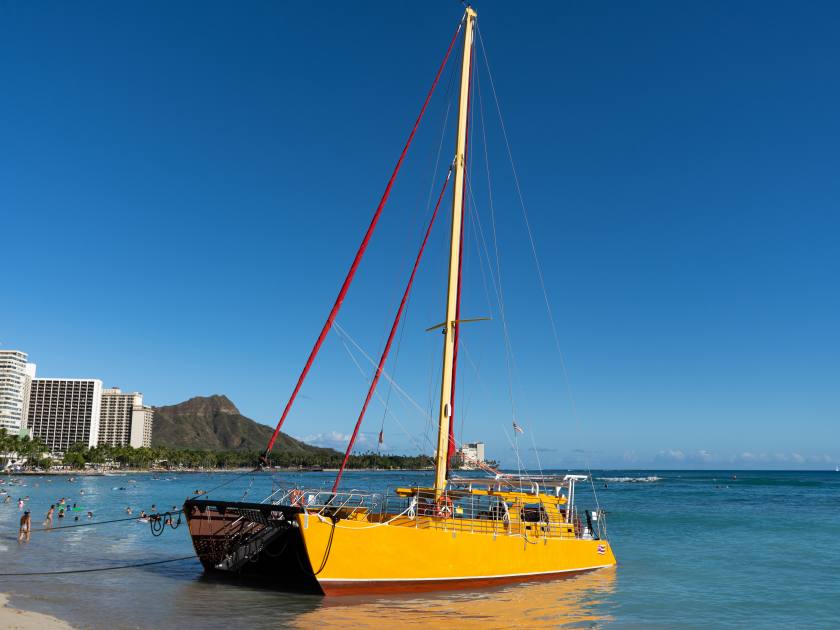
For those seeking a serene sea excursion, catamaran sailing off the coast of Waikiki provides a unique perspective of the city’s stunning skyline and Diamond Head’s majestic outline. Whether you opt for a sunrise cruise, a midday sail, or a sunset journey, sailing in Waikiki is an experience not to be missed.
Accommodations in Waikiki
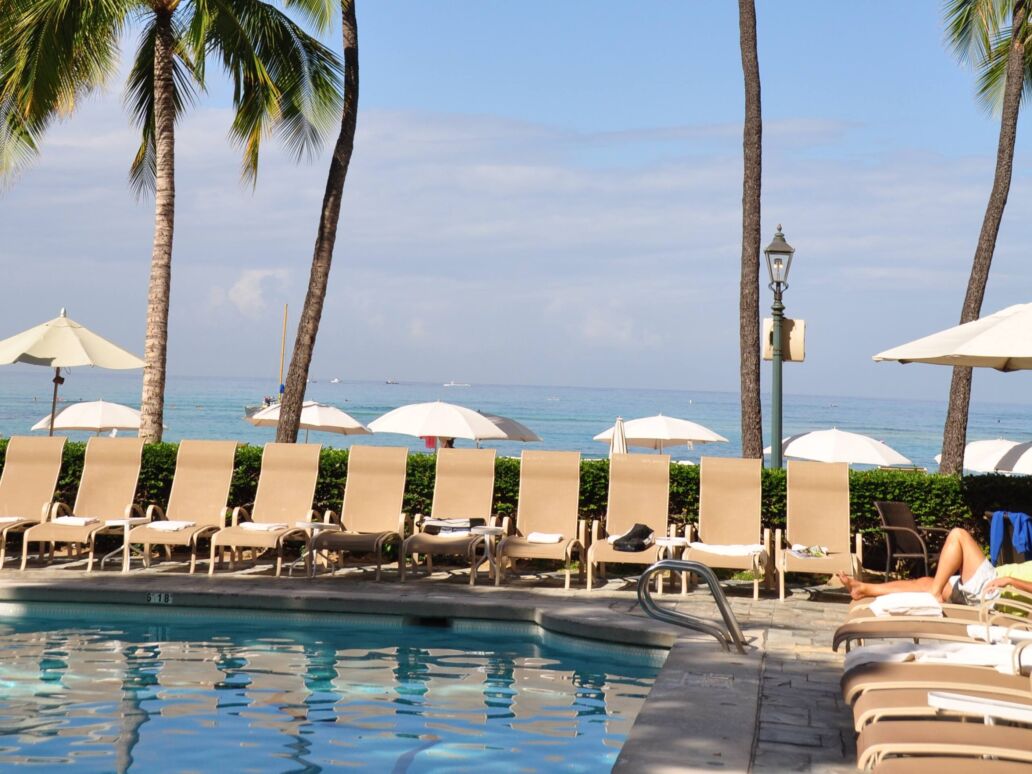
Waikiki welcomes its visitors with a vast range of accommodations, designed to fit the needs and preferences of every traveler. From the luxurious oceanfront resorts that offer unparalleled views and top-notch amenities, to the budget-friendly hotels providing comfort and convenience, there is something for every kind of traveler. Notable names in the luxury category include The Royal Hawaiian and Halekulani. For budget-conscious travelers, options such as Hyatt Place Waikiki Beach and Aqua Aloha Surf Waikiki offer excellent value for money. Vacation rentals and bed-and-breakfast options also abound, providing a more intimate and personalized stay in this paradise. Regardless of where you choose to stay, the warm Aloha spirit of Hawaii is sure to make your experience in Waikiki truly special.
Local Cuisine
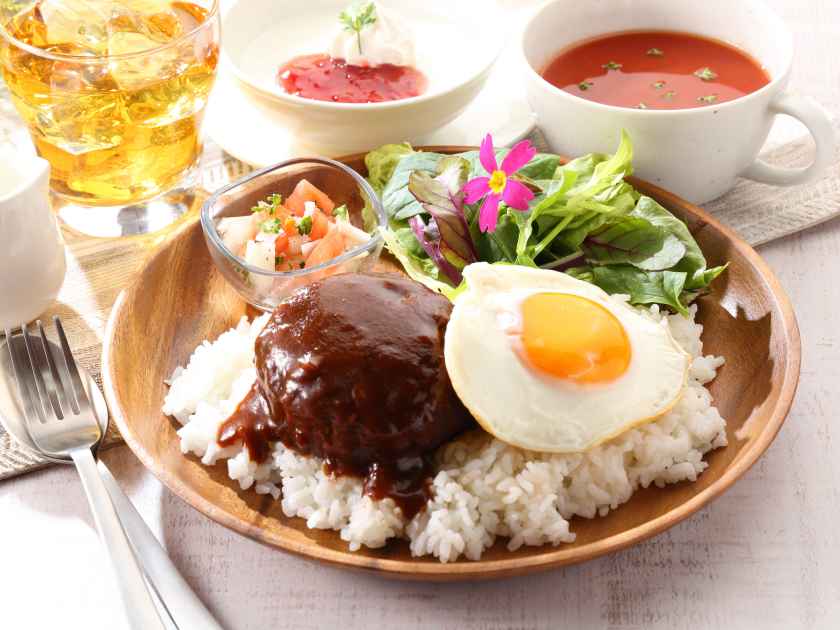
The gastronomic scene in Waikiki is as diverse and vibrant as its culture. It’s a culinary paradise with an impressive array of restaurants offering both local and international cuisines. Traditional Hawaiian dishes like poke (a raw fish salad), loco moco (a dish featuring white rice, a hamburger patty, a fried egg, and brown gravy), and spam musubi (a sushi-style snack made with spam on a block of rice, wrapped in nori) are must-try. Waikiki also boasts a multitude of food trucks serving everything from fresh seafood to Hawaiian-style BBQ, making it a fantastic destination for foodies. Make sure to also sample the world-renowned Kona coffee and delightful tropical fruits.
Events and Festivals
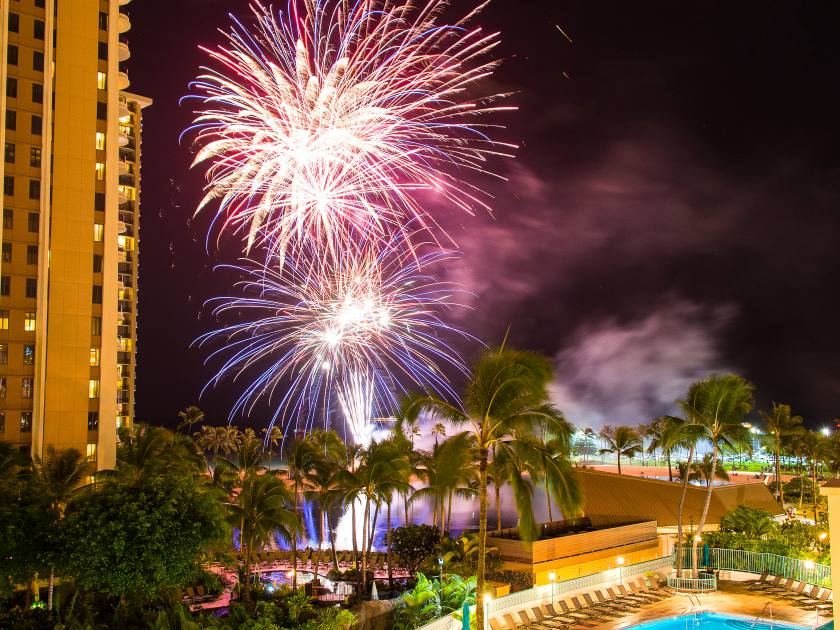
Throughout the year, Waikiki hosts an array of festivals and events that capture the regional spirit and Hawaiian traditions. Among these, the Aloha Festivals stand out, a city-wide celebration of Hawaiian culture featuring parades, hula performances, and live music. The Waikiki Hoolaulea is another exciting event, which transforms Kalakaua Avenue into a massive block party with local food, crafts, and entertainment. For surf enthusiasts, the Duke’s OceanFest is a must-see, commemorating the legacy of Duke Kahanamoku with a week of watersport competitions. These events not only add to the city’s vibrant atmosphere but also provide a deeper appreciation of Hawaii’s rich cultural heritage.
Tips for Visiting
- Pack Sun Protection: Protect yourself from sunburn, especially if you plan to spend extended periods on the beach or exploring outdoor attractions.
- Comfortable Footwear: Bring comfortable shoes for strolling along the beach, exploring the streets, and tackling scenic hikes like Diamond Head.
- Explore Local Cuisine: Sample fresh poke, plate lunches, and shave ice. Don’t miss a traditional Hawaiian luau for an authentic culinary and cultural experience.
- Learn Basic Hawaiian Phrases: While English is widely spoken, locals appreciate visitors who make an effort to use basic Hawaiian phrases. A simple “Aloha” (hello) and “Mahalo” (thank you) can go a long way.
- Experience a Luau: Attend a traditional Hawaiian luau to witness cultural performances, hula dancing, and indulge in delicious local cuisine.
- Respect Local Culture: Stay on marked trails during hikes, avoid touching marine life while snorkeling, and be mindful of cultural sites. Leave no trace and embrace the local spirit.
- Take a Surf Lesson: Whether you’re a beginner or an experienced surfer, consider taking a lesson from the Waikiki Beach Boys to ride the iconic waves.
- Enjoy Sunset Traditions: Witness the stunning sunset at Waikiki Beach. Join a sunset cruise, take a romantic stroll, or simply relax on the sand. It’s a magical way to end your day in paradise.
- Stay Hydrated: Carry a reusable water bottle and stay hydrated, especially if you’re engaging in outdoor activities.
- Take Advantage of Free Hula Shows: Enjoy free hula shows along Waikiki’s Kuhio Beach. These performances showcase the beauty of Hawaiian dance and music, adding a cultural touch to your visit.
Best Time to Visit Waikiki
The ideal time to visit Waikiki hinges greatly on the weather and individual preferences for activities. Typically, the region experiences a tropical climate that makes it an attractive destination all year round. However, certain seasons offer unique advantages. The period from mid-April to early June and September to mid-December offers pleasant weather with fewer crowds, making it perfect for those seeking a peaceful getaway. Conversely, surf enthusiasts might find winter months, specifically December to February, more appealing due to the larger waves. Keep in mind that “Waikiki weather” is characterized by occasional rainfall, but the frequent sunshine ensures it rarely dampers the holiday spirit. It’s prudent to keep an eye on “seasonal travel tips” for Hawaii to make the most of your visit.
Frequently Asked Questions
Waikiki is renowned for its stunning beach, surf culture, and vibrant nightlife. It’s a hub for tourists due to its array of attractions. The city’s rich history, diverse cuisine, and range of accommodations also contribute to its fame.
While often used interchangeably in conversation, Waikiki and Honolulu are not the same place. Honolulu is the capital city of Hawaii and encompasses a large area on the island of Oahu. Waikiki, on the other hand, is a neighborhood within Honolulu known for its famous beach and is a primary tourist destination.
Yes, Waikiki is a popular tourist destination and can get crowded, particularly during peak seasons. However, its vibrant atmosphere, beautiful beach, and array of activities make it a place worth visiting. If you prefer a quieter experience, there are many less crowded beaches and attractions within a short drive.
The name “Waikiki” translates to “spouting fresh water” in Hawaiian, a nod to the numerous freshwater springs and rivers that once flowed into the area. This abundant flow of fresh water made Waikiki an ideal spot for early Hawaiians to settle and cultivate taro.
Families can enjoy activities like the Honolulu Zoo, the Waikiki Aquarium, and the Duke Kahanamoku Lagoon. Many hotels also offer kid-friendly amenities, and the gentle waves of Waikiki Beach make it suitable for family water adventures.
Immerse yourself in Hawaiian culture by attending a luau, watching hula performances at Kuhio Beach, and visiting the Polynesian Cultural Center. Many hotels also host cultural events, providing guests with a rich taste of local traditions.
How to Get There
By Car
If you’re driving to Waikiki, you can access it via the H-1 Highway from Honolulu International Airport, which is approximately a 20-minute drive depending on traffic. If you’re heading from the North Shore, take the H-2 Highway south to connect to H-1 East and continue until you reach the Waikiki exit. Waikiki offers various parking options, including street parking and paid lots. Some hotels provide valet services, and there are public garages available.
By Bus
To reach Waikiki by bus, you can use TheBus, Honolulu’s reliable public transit system. Route 19, 20, and 31 serve Waikiki from the Honolulu International Airport. TheBus is a cost-effective and eco-friendly option, providing a chance to enjoy scenic views. The trip usually takes around an hour, depending on traffic.
Waikiki is an Idyllic Destination that Truly has it All
Every experience in Waikiki leaves a lasting impression. Make the most of your time in this tropical haven by planning ahead and ensuring a seamless and enjoyable experience. Your Waikiki adventure awaits—seize the opportunity to create lasting memories in one of the world’s most enchanting destinations!


